Home › Forums › Air and Sea › Air › 100 Years Ago
- This topic has 43 replies, 8 voices, and was last updated 7 years, 10 months ago by
 Don Glewwe.
Don Glewwe.
-
AuthorPosts
-
17/01/2016 at 18:52 #36768
 Don GlewweParticipant
Don GlewweParticipantThis is a centennial thing I was hoping to start last year, but…well…

I’ve always looked to the “Today” feature of the Aerodrome website ( http://www.theaerodrome.com/today/today.cgi ) for scenario ideas.
I hope to use it now to inspire regular playtesting and revision of my rules.For today’s event I chose Walter Hohndorf’s first official claim over a Voisin. To be honest, I like the appeal of the other two (Powell or Grenfell) but I haven’t gotten around to building an FE8 or Morane Parasol yet – hopefully I can catch one or both of them later in the year.
Here’s a photo of today’s game: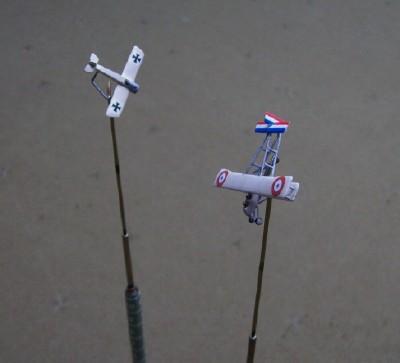
As with the other early war, one-on-one games I’ve tried, this one fell to the dice: There are just so many things that can be done in such limited-maneuver aircraft, and it all comes down to how lucky one is.The outcome turned out to be sensible (to me, at least). Without speed, maneuverability, or armament in its favor the Voisin did fairly well by diving/dodging about a bit until the moment came when a run for the lines became possible. Unfortunately, luck was not with it and the Fokker was able to maintain contact (albeit from long range) and score enough hits until the poor Frenchman simply fell apart from trying to push a dive past what his riddled aircraft could sustain.
In truth, not much of a game (nor was it expected to be). Still, an enjoyable hour that revealed gaps and flaws in the rules, and that made it worthwhile.
As I said at the top: I hope to continue adding to this thread as the year goes on…fingers crossed!18/01/2016 at 05:49 #36794 kyoteblueParticipant
kyoteblueParticipantGreat looking areo-planes.
19/01/2016 at 20:45 #36967 Don GlewweParticipant
Don GlewweParticipant(Easy to do another as it used the same models!)
Today I could have let Hohndorf get his second, but chose to move up to the coast and let Wilhelm Frankl have a go.*
The Voisin didn’t bother dodging about, and just put the nose down and ran while doing some minor (ineffective) jinking. As many a record shows, this usually isn’t a good move, and such was the case here. Once fixed on the tail, the Fokker simply hammered away and managed to caused a fuel leak, hit/smoke the engine, and wound the pilot.
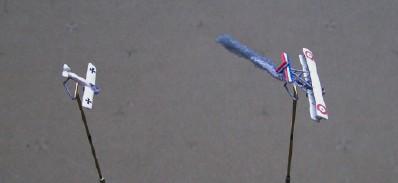
The Voisin made it to the lines and if lucky (ie: no fire started) may have managed to force land safely. Frankl had to forego the chase as he seriously overstressed the EIII in the dive and subsequent pullout: he’d have sweat a bit getting the Fokker down in one piece, so not really a pain-free victory.
* Although the same aircraft matched up, I made the German characteristics different. Hohndorf had been a good pilot (based on his experience and future as a test pilot) and I chose to have Frankl be a good shot (based on his downing of a Voisin with a carbine). This latter quality allowed for critical hits to be made (fuel tank, engine, pilot).24/01/2016 at 12:25 #37218 Don GlewweParticipant
Don GlewweParticipantOn the coast again, this time with Redford Mulock (1st Canadian and RNAS ace) of 1W against a German reconnaissance machine.
History didn’t exactly play out this time. After overcoming a poor starting position, Mulock used the superior maneuverability of his Nieuport to attain a solid lock on the tail of the Albatros.
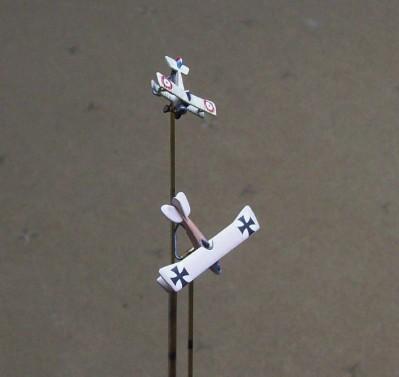
Though he scored solid hits (damaging the engine and controls) the limited ammunition of the Lewis gun told against the Canadian as the German was able to dive away and put a solid mile between them as precious time was spent reloading.
Resuming the chase only brought the Nieuport to within a 1000 yards before the Albatros crossed the (game determined) safety of the lines and Mulock turned back. (Also influencing this outcome was the damage already done to the Nieuport by overstressing during the high-speed diving pursuit.)He’ll get another chance on Tuesday.
25/01/2016 at 14:13 #37255 Don GlewweParticipant
Don GlewweParticipantOver the Dardenelles today as Hans-Joachim Buddecke scores against a Farman.
Another game where the outcome was no surprise, but still a valuable playtest insofar as getting ‘expected’ results goes a bit towards verifying the thing.(?)
The British pilot at first ventured into a maneuvering contest with the Fokker, and though he failed to allow his observer any sort of shot, he did manage to spoil Buddecke’s aim for most of a minute or so, limiting the severity of the German’s hits.
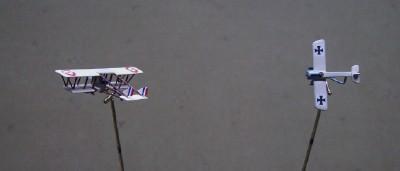
Jumping on an opportunity to flee, the Farman managed to build a lead of over a half mile in a desperate dive that caused more than a little creaking, snapping, and cracking of the old Shorthorn.
Dogged pursuit by Buddecke paid off, however, as he slowly worked his way closer until his shooting was rewarded by critical hits: smoking the engine, seriously damaging the controls, and wounding the pilot. The smoke blossomed into fire the next turn and it was all over.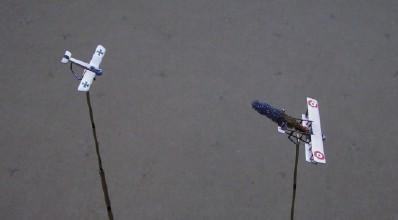 26/01/2016 at 21:05 #37330
26/01/2016 at 21:05 #37330 Don GlewweParticipant
Don GlewweParticipantBack to the coast as Mulock goes after another C-type (an LVG this time).
Once more the limited ammunition of the Lewis gun almost spelled defeat for the Canadian as his first shots did no critical damage, and his prey put a half mile and 1000′ between them while time was spent reloading. (It didn’t help that the German observer had put a bullet or two into the Nieuport’s engine, severely limiting the power available.)
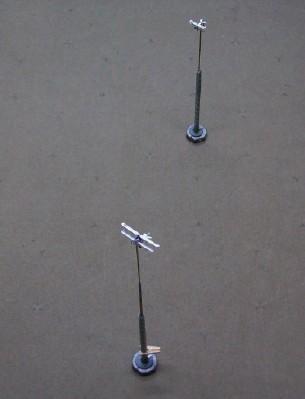
The game had a long way to go yet. During the eight mile flight to the lines, Mulock emptied two more drums at the German – damaging the controls, wounding the pilot, and putting enough holes in the LVG to prohibit any action beyond nursing it back home. The observer was still in the game, however, and scored two critical hits himself as the Nieuport closed in: doing enough structural damage to make Mulock’s safe return problematic as well.
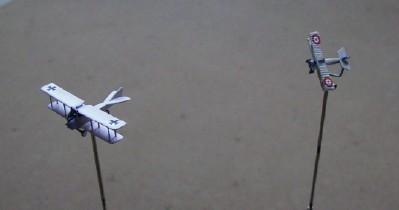
The fourth drum was emptied into the German over the lines, and both headed towards their respective bases. Rolling for landings saw both successful – though it was a white-knuckle affair for the wounded German.
Lesson learned: Being on the tail of an aircraft is a good place, but take the time to put yourself where the observer can’t shoot back! Mulock’s failure to allocate some of his maneuvering efforts to this almost cost him dearly.
It was interesting to play out a pursuit like this: 8+ miles and 10 minutes of real time taking around an hour and a half of gametime (including time for photos and feeding the dog…).
27/01/2016 at 21:08 #37381 Don GlewweParticipant
Don GlewweParticipantContinuing the leap-frog across the continent: Over the Gallipoli peninsula with Buddecke again going against a Farman. The spin/story to explain today’s game is that the British pilot thought he was in the squadron’s Bristol Scout…
With the Fokker in front of him and 10 miles of sea to fly over to get to his base (not an attractive task with an Eindecker chasing you), the Shorthorn chose to dogfight. Surprisingly, the Englishman got the upper hand in the first round or two (that’s dice for you…), though no shots of either combatant landed to any meaningful effect. Makes for an interesting picture, though…
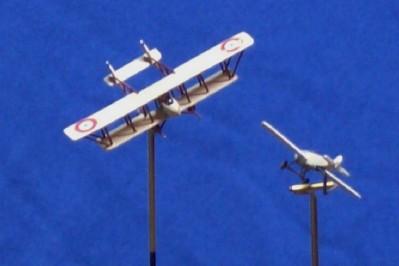
Not surprisingly, a Shorthorn is not a Scout, and yanking it around the sky as if it were can only lead to one thing: a spin (and the earning of a pink ring of shame).
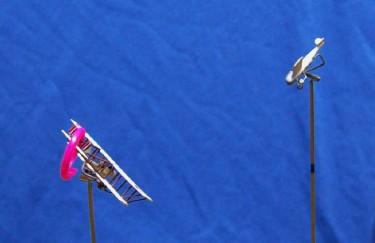
Buddecke followed down, putting holes in the poor Farman until managing a critical hit that damaged the Shorthorn’s controls and pretty much eliminated any chance of recovering from the spin.
A break, now, until next month…
01/02/2016 at 14:38 #37613 Don GlewweParticipant
Don GlewweParticipantOver the French section of the Somme front today as Wilhelm Frankl chases a snooping Voisin back to its side of the lines.
The claim cites Chaulnes as the location, so I made it a bit more difficult for the German by beginning the encounter only two miles from the line – this gave him only a few turns (ended up being 10) to score a victory. The Frenchman made it more difficult by coaxing full power/speed from the engine right from the start, allowing him to remain at long range for the majority of the pursuit.

Frankl burned through ~150 rounds putting plenty of holes in his target, but had only a ‘hero’s wound’ to the pilot to show for his efforts -the Voisin is a tough old bird- and the Frenchman made it to the trenches. A parting volley ensured that the landing would be fraught with a bit of trepidation but was handled successfully.
Further pursuit was called off not only by the dictate that the Fokker remain on its own side of the lines, but moreso by the fact that the Spandau jammed during the last shot.A bit of babble…
Gaming this sort of encounter seems a bit silly, I suppose, but I see gains to be had in a few areas:
-Isolating the action to just two aircraft (especially early-war ones with limited opportunities) highlights the basics of the game, revealing unattractive facets that may be buried/glossed-over in a larger, more complex scenario.
-The results -while not entirely predictable in every detail- point to the fact that victories take time, so that if the encounter were in a more crowded sky the leisure to spend minutes/miles poking away at a single foe would not exist, and ‘sure kills’ would come at the risk of being attacked by the friends of one’s target.
-The game’s nature (more RPG-ish than the usual ‘point-and-shoot’ aircombat game) does a decent job of creating a story that is interesting to follow along with. There is a certain amount of ‘drama in the dice’, as it were, and finding out what will happen next is enjoyable (imo), making the playing of these sort of seemingly unsurprising scenarios more than just a dull exercise. YMMV, but I like the idea of a different path to fun in gaming aircombat, thus this venture.02/02/2016 at 11:20 #37648 Don GlewweParticipant
Don GlewweParticipantSecond verse, same as the first…
The French had another go at the recon mission over the Somme. This time, it was Rudolph ‘Iron Man’ Berthold’s turn to get in their way, logging his first claim. Like yesterday, history didn’t repeat itself, though, and the short distance to the lines allowed the Frenchman to escape with nothing more than a repair order for his fitter.
Using the big, empty sky, the Voisin simply angled away from the Fokker (which started a bit to the north) as it made its way to the line (taking 13 turns instead of the 10 of yesterday). Berthold slowly reeled in his prey, but by the time he managed to get within effective range the trenches were less than 1000 yards away and the Frenchman put the nose down and dove for safety. One last volley yielded some serious control damage, but not enough to prevent escape (and a subsequent successful landing).
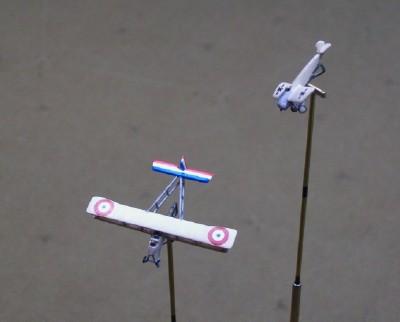
The Voisin may not have had as much room to run had I chosen to play out the version of history that had Berthold teamed with Ernst von Althaus (who was credited with a Voisin a few miles to the north) against him – I may give that a go after work today.
02/02/2016 at 12:23 #37653 RogerBWParticipant
RogerBWParticipantWould you be willing to post a photo of an aircraft record sheet in play? I’d love to get an idea of the practical level of complexity.
02/02/2016 at 22:48 #37683 Don GlewweParticipant
Don GlewweParticipantSecond game: As expected, the big sky wasn’t there this time. During the cat-and-mouse stalking/evading contest as the three worked closer to the lines, the Voisin could get the drop on one of the Fokkers every now and again, but never fooled both – as in this photo showing the Frenchman turning in behind the nearer German, but still facing the other:
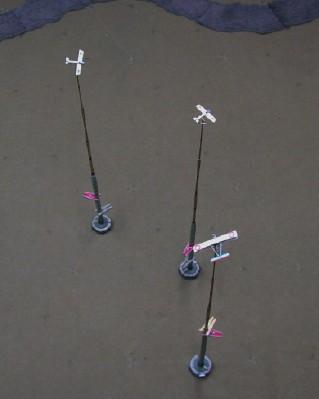
Once the Germans closed in they ran the risk of collision, but no such luck for the French. Finally cornered, the Voisin played the ‘nose-down-and-run’ card and came close to making it across the lines, but the last heavy fire it took over the trenches proved to be too much and the riddled ‘craft finally fell to pieces (a critical hit by von Althaus rolled snake-eyes).
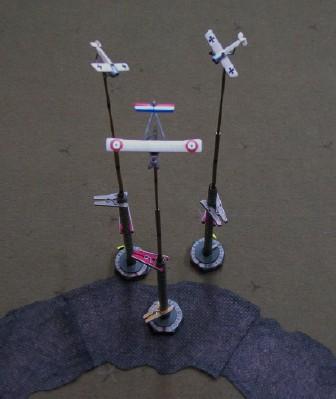 02/02/2016 at 22:52 #37684
02/02/2016 at 22:52 #37684 Don GlewweParticipant
Don GlewweParticipantWould you be willing to post a photo of an aircraft record sheet in play? I’d love to get an idea of the practical level of complexity.
Not sure what you were looking for / expecting, but here’s a shot of the logs at the end of the last game:
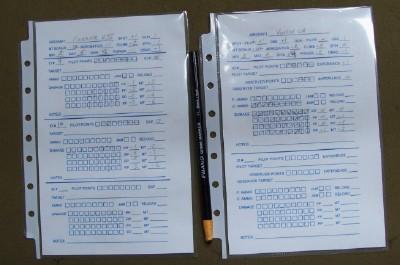
I use a grease pencil to mark damage, as well as track ammo use, jams, and each turn’s use of Pilot Points.*
There’s another thread (‘Gweirda’s Odd POV’) where it may be better to handle discussion of the rules (as opposed to these particular games)? dunno…any way is fine with me.
*the Pilot Points idea stolen from Mike Clinton’s “Watch Your Six” rules: As usual, I highly recommend them as they are -as opposed to my scribblings- a ‘real’ set of playtested rules.
02/02/2016 at 23:22 #37685 RogerBWParticipant
RogerBWParticipantThanks – I was trying to get some idea of the level of complexity/detal. I think the scale, as in number of units, in a wargame is one of the most important decisions for a designer to make: you’re clearly optimising for one-on-one or at least small battles (noting the role-playing element), rather than huge dogfights as some games do.
03/02/2016 at 01:20 #37692 Don GlewweParticipant
Don GlewweParticipant…you’re clearly optimising for one-on-one or at least small battles (noting the role-playing element), rather than huge dogfights as some games do.
Not really…or perhaps I’m confused (the most likely). I see my effort as being towards larger games where players can control a flight (4-6 aircraft) or even up to a squadron. Getting enough players around the table for a decent-sized game is, imo, a problem with the genre, and I’m aiming at providing something two or three can use to put a good number of aircraft in the air (or even solo) without creating too much of a robot-pilots effect from too much control.
03/02/2016 at 02:16 #37693Etranger
ParticipantI’m enjoying this series!
03/02/2016 at 18:56 #37721 Don GlewweParticipant
Don GlewweParticipantOver the Somme again. Georges Guynemer becomes an ace by downing an LVG.
Conserving the few seconds of ammunition available, he held his fire until close in (always mindful of positioning himself out of the observer’s line of fire) before sending two 2-second bursts into the engine and pilot.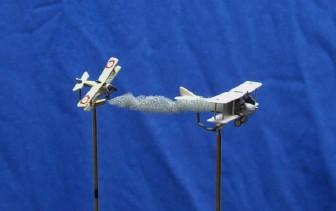
Trailing smoke and fearful of fire, the wounded German angled off from the Nieuport as Guynemer reloaded. They were a mile apart when the reload was accomplished, and I declined to finish the encounter as I judged that it was as good a victory as many (or most) and didn’t need coloring in (there was also snow that needed shoveling ). Rolling for the LVG’s landing attempt resulted in the wounded pilot succumbing at the last and crashing, so it goes in the books as a solid kill.
Another example of a predictable encounter that contained no surprises. Given the time and space, if the fighter does everything right there’s little the observation ‘craft can do to prevent the inevitable. Still, as mentioned previously, it’s nice to see the rules work in situations like this.
04/02/2016 at 17:39 #37772 Don GlewweParticipant
Don GlewweParticipantOff Imbros in the Gallipoli theater today as Theodor Croneiss downs a Be2. (The site mentions Farman or Be as his target, but I went with the Quirk since there hadn’t been one yet and that just didn’t seem right )
Instead of trying to run/evade, the British pilot chose to take on the Fokker (-in game terms he rolled a high degree of ‘pluck’) and managed to maneuver to a draw in the first turns. The German decided ‘enough of this’ and raised his level of maneuvering a notch (-rolling a bit of a hallschmerzen himself) only to find himself stalled out – presenting an easy target for the Be2’s observer as the British pilot did a good job of following the drifting Fokker.
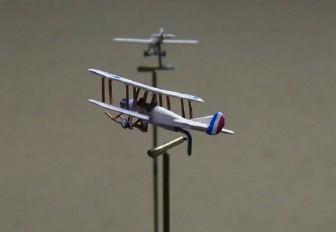
Unfortunately for the British, firing off a drum of ammo brought no significant damage…as well as jamming the Lewis! Still full of pluck, the Be2 continued pursuit (instead of choosing the better part of valour) while the observer worked frantically on his weapon, managing to get it fixed and loaded just in time for the two to close again. Both had blood in mind (though Croneiss may have simply wanted to save face…) and came at each other with no pretense of evasion. This time, however, the luck was with the German: the British observer was killed and the Quirk’s fuel tank holed. The poor Be2 pilot failed to notice his peril, and simply made a frantic, diving bid for safety as the Fokker dogged him every step of the way, firing all the while, until flames sprouted to seal the Quirk’s fate.
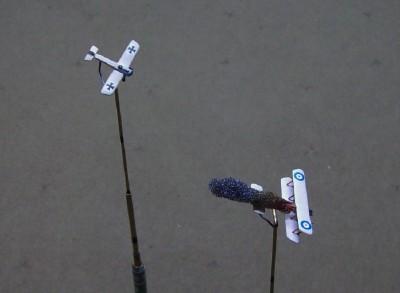 05/02/2016 at 14:50 #37857
05/02/2016 at 14:50 #37857 Don GlewweParticipant
Don GlewweParticipantToday was the Brits’ turn to be the hunter. I set up the DH-2 of Jack Cunningham (18 Sq) going after an Albatros over Carvin, but the thing was not to be. The German spotted him well out of gun range, powered up to max speed, turned to show his heels, and that was it.The pace of the little DH just wasn’t great enough to allow more than a desperate long range shot that did nothing to hinder the Albatros’ escape.
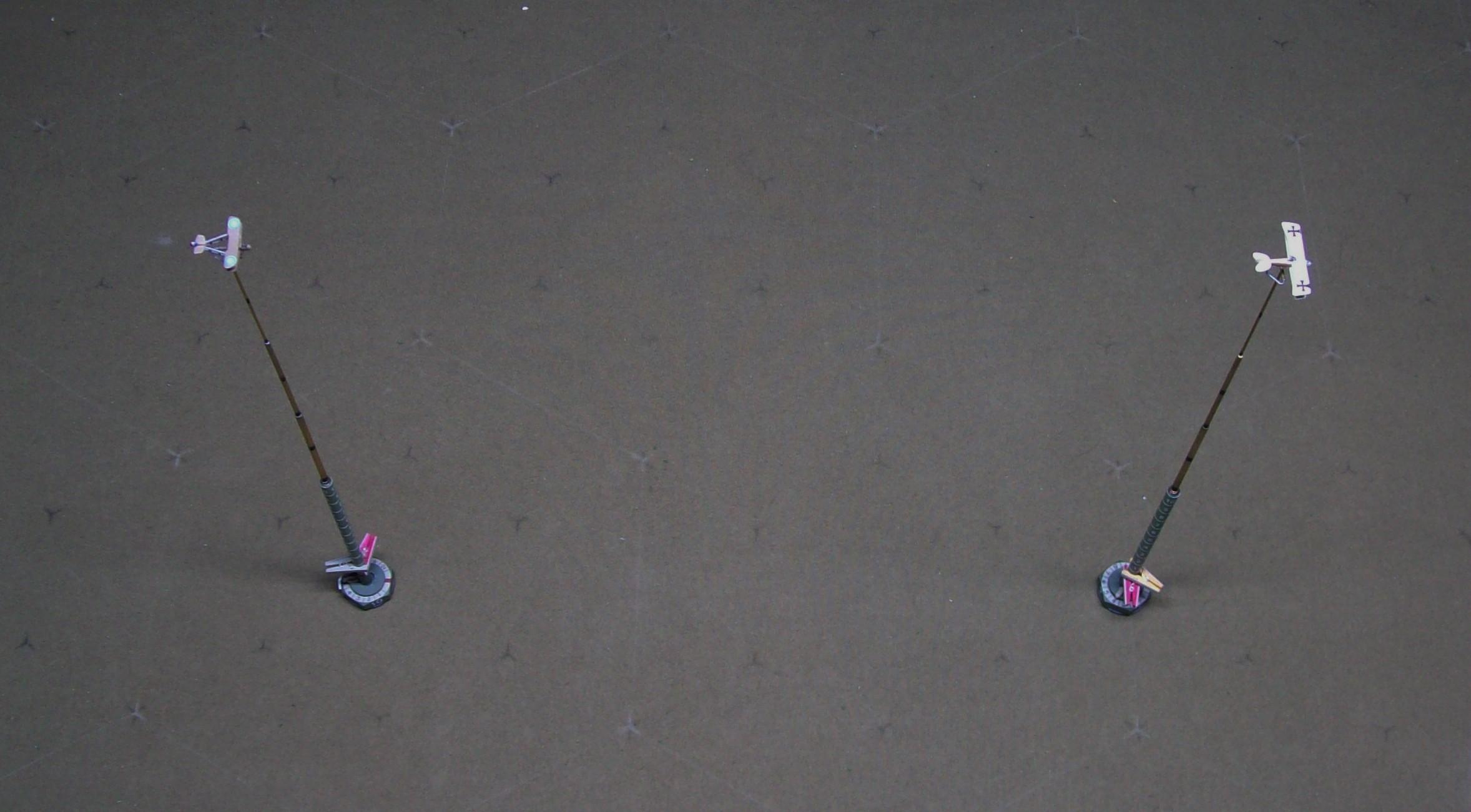
Not much of a game, so I decided to give William Strugnell (1 Sq) a go in a Morane. (His foe should have been an Aviatik, but I haven’t built one yet so the Albatros had to proxy.) The set up at the start ended up being the same (dice are funny that way sometimes…) and the German tried the same tactic but the Mercedes failed to respond with the same gusto, and the Bullet is half again faster than him than the de Havilland, so even a dive to gain speed didn’t prevent Strugnell from closing the range. The observer’s fire went wide but the Englishman’s shots were true, causing a fuel leak and seriously damaging the German’s controls.
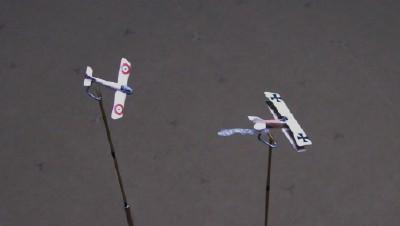
I didn’t take the time to play out the reloading and possible pursuit. The German succeeded in bringing his wounded bird in for a safe landing, but the result would still -as it did 100 years ago- go into the books as Strugnell’s first official claim.
07/02/2016 at 14:13 #37954 Don GlewweParticipant
Don GlewweParticipantThe first (for this thread) actual ‘fighter v fighter’ combat: Guy Reid and Billinge(obs) of 20 Sq pit their Fe2b against the Fokker of E.Kunz(?) of FFA 33 over Roulers (Roeselare).
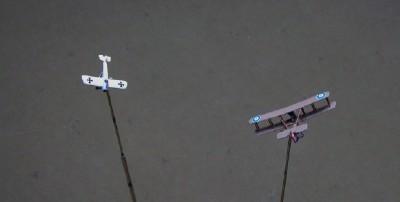
Taking place at 8200 feet, both ‘craft were well in the ‘wallowing’ category when it came to performance envelopes and both pilots ended up stalling during the encounter. The German was lucky to be reminded of how thin the air was before the range closed, and his stall didn’t cost more than pride. Reid, however, got the bit in his teeth (ie: rolled a very high degree of pluck) and pushed the Fee beyond what the wings could support at that altitude when Kunz was close enough to cash in on the mistake.
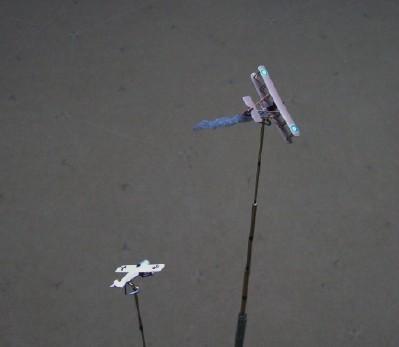
The Beardmore engine of the British pusher did what it usually did in these sort of situations, acting as a lump of bullet-stopping armor. Unfortunately for the British crew the clunking and smoking was only the beginning of the bad news from behind as fire sprouted after a few seconds.
The end was not colored in, as I felt that -even if diving/slipping managed to blow out the fire- the Fokker would be on hand all the way down to ensure that the best the Brits could hope for was to end up as POWs.08/02/2016 at 23:51 #38009 Don GlewweParticipant
Don GlewweParticipantQuite a long break ahead, so I thought perhaps to fill the gap, as it were, with a bit of explanation.
Pluck (British), elan (French), and hallschmerzen (German) are terms/labels I use to indicate a modifier of attitude when it comes to deciding (in a solo-gaming environment) whether a certain pilot/crewmember chooses to do one thing or another. They never -never- dictate that a pilot/crewmember does something suicidal or patently stupid. It is simply a modifier that may or may not determine whether the course of action chosen by the player results in something suicidal or patently stupid.
PS- I’d love to hear suggestions for an American term…
09/02/2016 at 01:17 #38010Etranger
ParticipantChutzpah? It may be an anachronism for WWI though!
09/02/2016 at 05:13 #38011 Mr. AverageParticipant
Mr. AverageParticipantI think the Americanism you’d be looking for is “guts.”
09/02/2016 at 09:23 #38016 RogerBWParticipant
RogerBWParticipantAnd if you were to extend the system to Finns (not so much in the Great War, clearly) it would undoubtedly be sisu.
09/02/2016 at 14:35 #38033 MishimaParticipant
MishimaParticipantVery enjoyable reading.
Tim from Gomi Designs. 15mm Vietnam riverine. www.gomidesigns.co.uk
10/02/2016 at 18:09 #38077 Don GlewweParticipant
Don GlewweParticipantInstead of fighter v fighter, today’s matchup sees a French MF 11 (Deullin, Colcomb MF62) go up against an LVG C-II. The ‘Today’ page doesn’t list the German aircraft type so I chose the LVG (rather than a Fokker) to make the odds closer. Even that didn’t help the French, as the Shorthorn (with a Hotchkiss MG) is pretty much outclassed by most (all?) it would meet in ’16, and instead of logging his first claim Deullin lost the fight.
The German’s first shots as they traded fire knocked out the French engine, and it was -literally- downhill from there.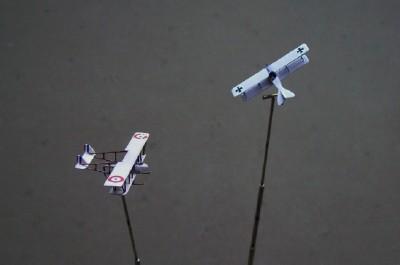
Deullin had the wit to switch off ignition and fuel to avoid a fire, and even managed to give the German the slip (setting up a shot for a rear observer provides better opportunity for such an escape). The big sky played its hand, though, and a three mile chase by the faster LVG eventually closed the range. The German blasted away -nearly emptying the Parabellum’s reel- but couldn’t do more than fill the Farman with holes.* Such constant fire did, however, result in a jamming of the gun. The German turned for home and Deullin glided towards a forced landing, which was unsuccessful – in game terms, all those holes (and ending up in poor ground) meant rolling 20 dice, and all it takes is a single ‘1’ to fail.
Another game where a one-on-one duel is decided more by luck than skill – perhaps like a Wild West street duel maybe? First one to roll a good hit wins. Not too much fun if you’re the one on the receiving end. As mentioned previously, however, the rules are aimed at larger battles where a crowded sky would act to counter that deficiency in two ways: Isolating one’s time on a single enemy leaves you open to attack from his friends, and being in control of a flight or more softens the blow of losing one to a (un)lucky shot.
*I thought of Albert Moris, who flew a Farman for 253 hours in the first months of the war, whose ground crew identified no less than 400 hits.

 26/02/2016 at 16:11 #38795
26/02/2016 at 16:11 #38795 Don GlewweParticipant
Don GlewweParticipantToday Jean Navarre becomes an ace. Patrolling south of Verdun, he finds a German recon mission snooping over the Meuse. He leaves the LVG to its work for the time being, and decides to stalk the escorting Fokker first.*
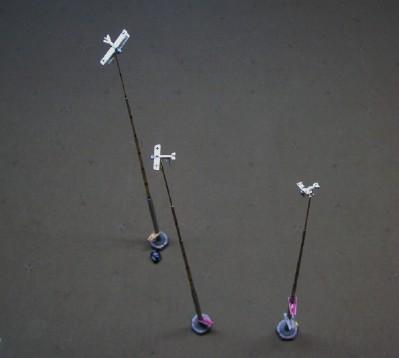
The German fails to spot the Nieuport until the range is closed, and by then it’s too late – the Eindecker has no chance of matching the Bebe’s maneuverability. The inevitable is put off briefly as Navarre’s first burst -though from very close- fails to do any significant damage (game note: 15 d6 rolled and not one ‘6’…sometimes that’s the way it goes). A second, longer burst hits the fuel tank, though, and the Fokker (whose pilot wisely switches off and dives away) is out of the action. Navarre keeps his cool and doesn’t pursue the stricken foe (who succeeds in gliding to a safe forced landing) but instead levels off and searches for the observation ‘craft. He makes a successful spot, and begins his second hunt of the day.
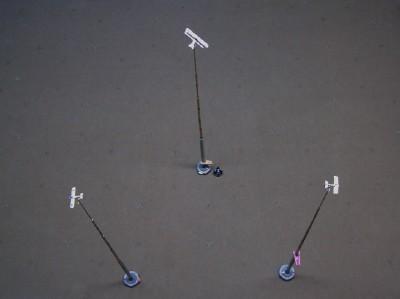
The LVG pilot notices his escort missing and scans the sky – no joy. The observer looks up to see something closing in, but the Nieuport quickly slips out of sight. Both Germans are busy searching the sky when Navarre empties his last two seconds of ammo into their engine.
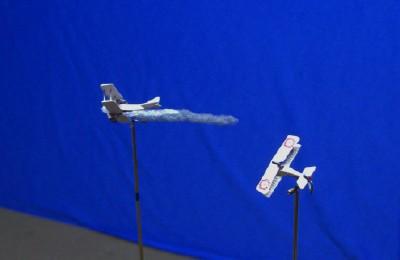
The German pilot panics and doesn’t notice the accompanying fuel leak, so no need to roll for a forced landing…
*While based on historical claims, all these games have been set up randomly (based on Mike Clinton’s excellent method as found in his ‘Watch Your Six!’ rules). As it turned out, Navarre got the drop on both Germans, but it could have gone the other way (witness his first attack for an example of how dice can create ‘I didn’t expect that to happen’ events). Choosing to attack the escort first is another break from history (at least based on what I could find of the incident) as the two-seater was downed first over the Meuse while the Eindecker’s ending took place ~8 miles away (on the German side of the lines) – presumably after a long-running battle/chase?
I mention this only to highlight how ‘historical scenario’ doesn’t necessarily mean ‘boring replay’, and adding more aircraft to the mix (as intended in the creation of the rules) will lessen the impact on the game of a single aberrant roll…hopefully. ; )
10/04/2016 at 20:14 #40505 Don GlewweParticipant
Don GlewweParticipantForgive me father, for I have sinned…it’s been 6 weeks since my last game.
A segue of sorts from my last entry, with the German taking the role of attacker as Walter Hohndorf (from the first game of this series) now of KEK Vaux intercepting a long reconnaissance from N68 – a Bebe escorting a Nieuport 12.* Pitting an E-IV model Eindecker with its two Spandaus against a Nieuport 11 looked to be a good opportunity to see what superior flying skill (for purpose of the game I made the French pilot -Tiberghien- of average quality while the former exhibition/test pilot -Hohndorf- had twice the Pilot Points) and firepower (the E-IV had two Spandaus vs the single 47-round Lewis of the Bebe) did against maneuverability.
The fates saw Hohndorf attacking from the front and slightly above. The French escort chose to steep-climb to the same altitude at the cost of energy he would soon regret losing.
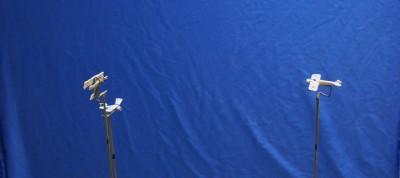
Confident in his ability to control his ‘craft, Hohndorf pushed the Fokker to the edge of the envelope to gain advantage over the Nieuport whose lower speed presented Tiberghien with a much smaller envelope and little in the way of maneuvering options. The first burst from the German went wide, but alerted the Frenchman to his peril in continuing the match on these terms.
Unfortunately, diving away -while solving the energy problem- was a card that Hohndorf could also play, and the result was no surprise: The Fokker perched on the Nieuport’s tail getting full use of the twin guns, smoking the Gnome engine and doing a fair amount of structural damage to the Bebe.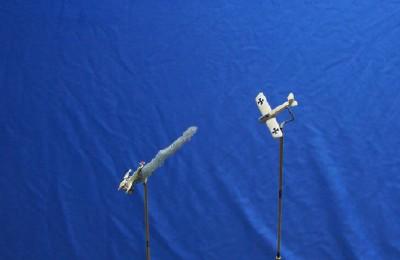
Tiberghien had a bit of luck insofar as he managed to both pull out of the dive before/without ripping off the wings, put a half mile or so between himself and pursuit, and -most happily- not see fire blossom. The bad news was that his dive away from his enemy was also away from the lines, and -though not played out- was assumed to result in capture at best. Still, the French reconnaissance machine managed to get away unscathed, so a victory of sorts?*another sin: I’ve not built a Nieuport 12 yet, so used an unfinished N17 as proxy. Shame on me
 16/04/2016 at 17:33 #40781
16/04/2016 at 17:33 #40781 Don GlewweParticipant
Don GlewweParticipant(I thought to skip playing this after having done so many similar actions, but that sort of thinking is what led to the 6-week hiatus, so…)
Rudolph Berthold, flying a Pfalz E-IV, scored his 5th victory today to become an ace -10 days before a crash that caused the first of many injuries he bore throughout the war to earn the nickname ‘Ironman’. His victim was a Be2c from 9 Squadron.
The setup phase resulted in the two facing each other head on – Berthold chose to increase the range by gaining an altitude advantage. The Quirk (taking advantage of a high movement roll) decided on the better part of valour and immediately turned and dove in the hope of keeping out of range of the German’s two Spandaus. Such was not to be, however, as Berthold easily kept up (having a 10-15mph speed advantage -and equally lucky dice rolls- is very handy) and was able to use his 30+months of flying experience to wrestle the most out of the contrary Pfalz and gain (and hold) a deadly firing position.
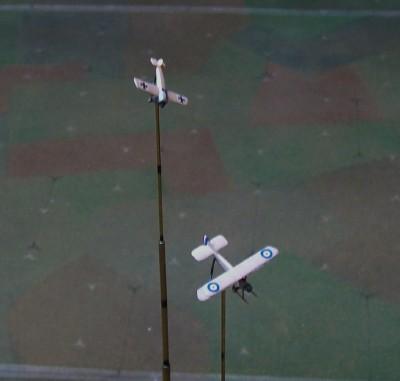
Many attack dice rolls later found the poor Quirk with its observer wounded and out of action, its controls all but completely shot away, and its structural integrity -damaged by both bullets and stress- hanging by a thread. As the earth came closer, it came as no surprise when Berthold -ready to line up another burst- saw the wings fold when the British pilot tried pulling out of his mad dive.Today’s game is a perfect example of what the Fokker Scourge was all about…in this case it was a Pfalz, but I’m sure the poor British who were shot down wouldn’t mark the distinction.
16/04/2016 at 20:49 #40786 Don GlewweParticipant
Don GlewweParticipantaack…he’s not a reindeer
s/b “Rudolf” …sorry
 17/04/2016 at 18:49 #40794
17/04/2016 at 18:49 #40794 Don GlewweParticipant
Don GlewweParticipantFritz Bernert of KEK Vaux scored his first victory today – a year from now during ‘Bloody April’ he’ll down five in one day. This year’s opponent was a Nieuport – I couldn’t find out what type it was, so for the game I chose a Bebe to make it a straight up fighter vs fighter match. Both pilots took few chances, and the superior climb and maneuverability of the Nieuport didn’t pay off as well as expected – the result was a duel that lasted seven minutes…certainly nothing either would get away with in a crowded sky.
The set up gave Bernert a slight positional and speed advantage, the latter of which came in very handy to match the Nieuport’s initial climb. The two faced off warily outside of gun range for a minute or so. Even after finally reducing the range the cautious dance continued as neither was able to gain a significant advantage – at this altitude both had limited maneuver envelopes, and both waited for a window of position and energy to open for them to strike.
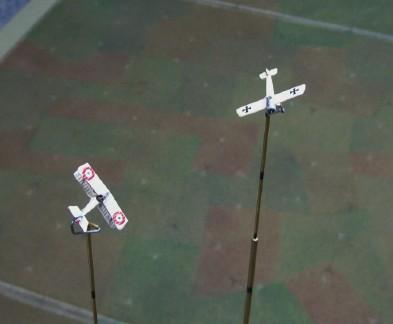
Both machines wallowed in the thin air as the pilots struggled to avoid stalling. The Frenchman never got his Gnome to supply power up to factory specs and could therefore not wring as much out of his ‘craft as he should – he stalled once, but managed to recover before Bernert could take advantage. Finally (after 39 turns) fate favored the Nieuport with an opportunity but then proved itself to be a heartless so-and-so by cursing the dice and crowning it with a pink ring of shame to mark a spin.
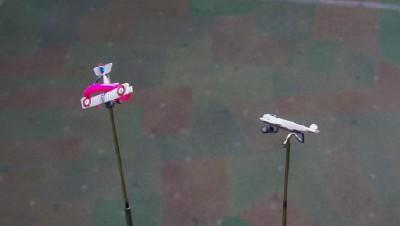
Bernert said ‘Thank you very much’, latched onto the stricken foe, and proceeded to give the Spandau a good workout stitching his name (and others of his immediate family) into the fabric of the poor Nieuport.
Recovery from the spin was (surprisingly) effected, but evasion was not on the menu for the Frenchman who had neither energy nor position with which to pay. The inevitable took a few turns as no critical hits were scored, but with no one to interfere Bernert was free to empty his ammo box at leisure until the Nieuport -its speed well into the ‘soon-to-break-up’ range- simply fell apart attempting to pull out of its dive.
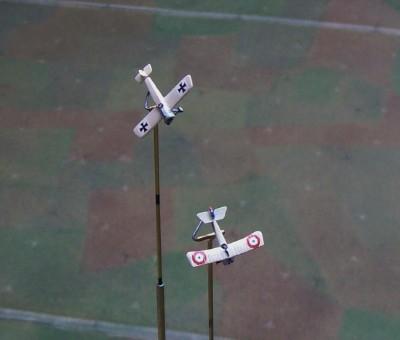
As mentioned above, this sort of victory would be difficult if not impossible to achieve if more than one enemy were about. Also, I have to admit that the game itself pushed the limit of patience/endurance as the dice took a long time to sort out an end – though I certainly don’t see the resulting AAR as being anything that could be labeled ahistorical. I suppose this would be no different than a one-on-one hand-to-hand fight using any of a number of RPG rules – in the end a risk taken here and a lucky roll there would decide the outcome. Whether such makes for an enjoyable game is, I guess, up to the player(s)?24/04/2016 at 18:04 #41177 Don GlewweParticipant
Don GlewweParticipantYesterday’s encounter between Immelmann, Mulzer, and an FB5 of 11 Sq was played at a local gaming group’s gameday, so no posting/photos. The result can be easily guessed at: While the Fokker Scourge is coming to an end, two Eindeckers are still more than a match for a lone Gunbus.
Today finds Jean Navarre (France’s first Ace) on another solo hunt in the Verdun sector. To make it more challenging the German reconnaissance machine was at 12,000′ (which significantly narrowed the Bebe’s performance envelope) and its crew were -while not as good as the Frenchman- better than average in ability and experience.
The setup placed Navarre climbing up on the rear quarter of the LVG, but was spotted outside of firing range so the Germans were ready for him.
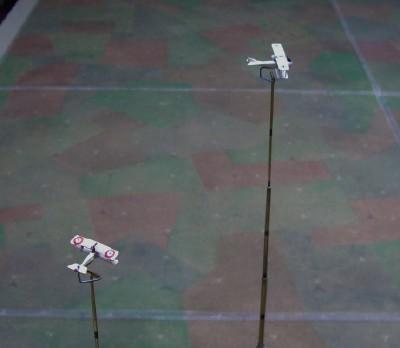
Once within range, the two entered into a duel of limited maneuvering, with neither pilot risking a stall by pushing for a significant advantage. Bullets were exchanged in short, ineffective bursts that did little but to remind each to remain on their guard.After two minutes or so of this, Navarre -with only one burst left in his ammo drum- saw a window of opportunity and made the best of it, climbing a little above to gain a superior position. Rather than wait to improve the shot from ‘good’ to ‘great’ in a subsequent turn (and risk the equally improved return fire) the Frenchman emptied his remaining rounds into the German ‘craft.
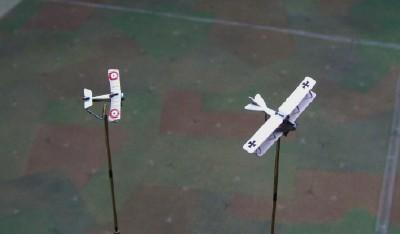
The controls on the LVG were shot up a bit, but not so much that the experienced pilot couldn’t handle it (as long as no one was also shooting at him…). Navarre only needed a half-minute to reload, but that was enough for the German to put his nose down and dive away.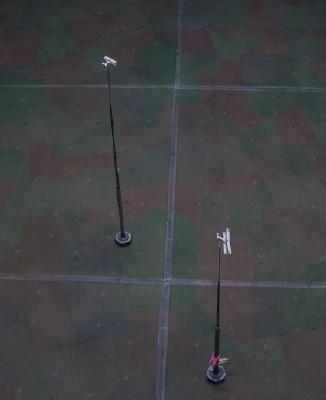
The pursuit was joined with the LVG holding an advantage of 1000′ of altitude and a little under a mile – distance the Bebe couldn’t hope to overcome unless it was pushed beyond the limits the experienced Navarre knew well and chose not to risk. The encounter ended (as many did) with the hunter and prey living to fight another day.25/04/2016 at 14:08 #41210 Iain FullerParticipant
Iain FullerParticipantMarvellous sir, just had a lovely time reading through these.
25/04/2016 at 15:22 #41220 Don GlewweParticipant
Don GlewweParticipantGlad to hear. I’ll admit that it’s sometimes a struggle to gather the gumption to spend the time on this, but once the dice start rolling the game grows a life and it becomes enjoyable to see how it unfolds.
Another Ace -Charles Nungesser, the French equivalent of ‘Iron Man’ Berthold- takes his turn over Verdun against an LVG today. I made the German crew as capable as it was yesterday and started it at the same altitude. The setup put almost a mile between the two, but the superior speed (and lucky die rolls!) allowed the Nieuport to close the range quickly, and soon the two were dueling. Like yesterday, neither took any risks that left an opening. At one point, an advantage by Nungesser resulted in a decent shot that caused a fair amount of damage, but at the cost of half a drum of ammo – and the German was still well in the fight.
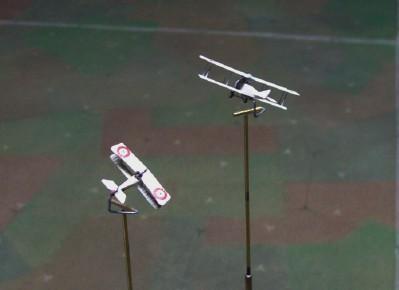
Diving to gain speed/energy, the LVG managed to maneuver more effectively, but not anywhere near what the nimble Neiuport could match and more than exceed with the capable French Ace at the controls. Holding fire to preserve his last two seconds of ammo, Nungesser patiently worked his way closer, ignoring the wild shots of the German observer ( -maneuvering as the LVG pilot was spoiled his Franz’s aim more than it did Nungesser’s). A one-second burst from the Lewis smoked the German’s engine.
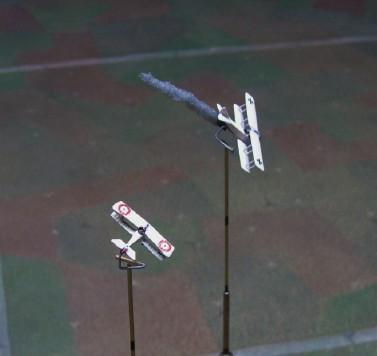
The German pilot kept his cool and did his best to escape while keeping his ‘craft under control, but couldn’t shake the Frenchman. As the Nieuport closed in to empty its last rounds into its stricken foe, fire started to spread along the LVG’s side. Perhaps distracted by this and wondering whether to bother firing, Nungesser failed to spot the danger posed by the observer who ignored the flames and got off a final, defiant (long-odds) shot that hit and severely wounded the Frenchman.
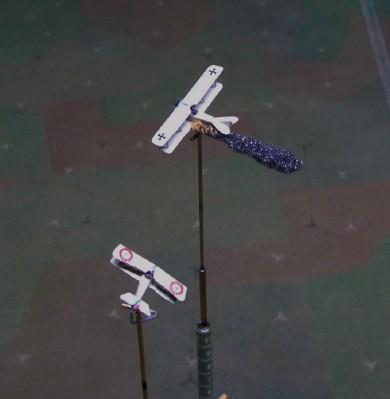
With the wounded Nungesser forced to retire, I rolled for the survival of the Germans. The fire was extinguished before causing too much damage, and they were able to glide back across the lines (being 2 miles high was helpful). Their luck continued to hold as the pilot was able to guide his battered ‘craft to a safe (if not very pretty) landing.If this occured 100 years ago, it is very likely that the LVG (and/or its crew) could end up in the history books as being both casualties on the day as well as surviving to the end of the war. C’est la guerre!
26/04/2016 at 17:28 #41285 Don GlewweParticipant
Don GlewweParticipantAn Fe2b from 18 Sq (piloted by J.Callaghan with observer J.Mitchell) has its photo recon mission north of Arras interrupted by a trio of Fokkers from FFA 62. (I took Callaghan’s subsequent ‘Mad Major’ nickname and willingness to attack a formation of D-VIIs alone as license to give him more than a fair share of ‘pluck’.) The encounter was placed over the German’s second trenchline, so safety for the British was but a short mile away…if they could make it.
The set up spread the Germans out quite a bit (entering from different points and different turns), but their speed and the British crew’s preoccupation with their photography mission meant that the poor Fee was soon in a flock of Fokkers.
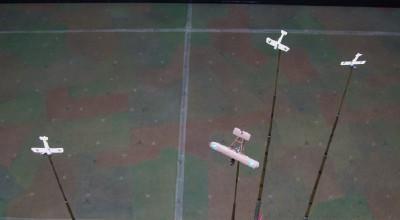
Callaghan’s concentration on the first German to reach him was disrupted by fire from the other two, and he put aside thoughts of ‘fight’ and turned to ‘flight’. (game note: morale check failure from taking fire/hits from 3rd party) The move put him out of range of all but one German for a bit, but he was headed in the wrong direction!
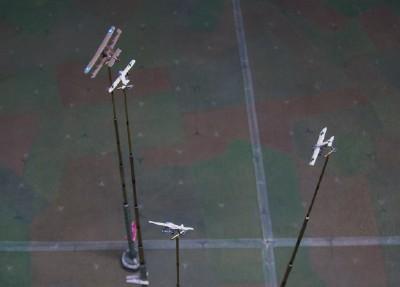
Soon surrounded once more, the Fee was absorbing a lot of damage – though the Brits were lucky in that no critical hits were scored, and the big Fee can take a lot of rifle-caliber rounds. A lucky opportunity to get the drop on his opponents let Callaghan flee the furball once again – this time in the correct direction! One Fokker followed, but two others were left looking for where the Fee went – thus occupied, they failed to spot each other and suffered a collision which yielded only minor damage but took them out of the battle for a good bit while they sorted themselves out.
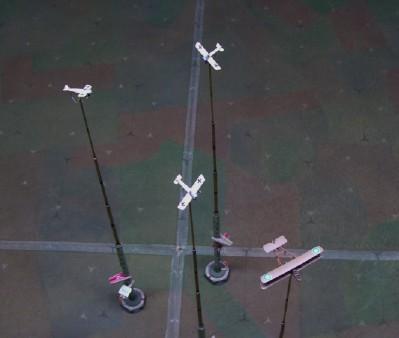
With just one Eindecker to deal with, Callaghan turned to face pursuit. Both pilots set caution aside and went at each other with no thought for evading the other’s fire. In the ensuing fusillade both ‘craft were hit hard, but again the Fee got off with just lots and lots of structurally-threatening holes, but the Fokker’s engine was destroyed/smoked.
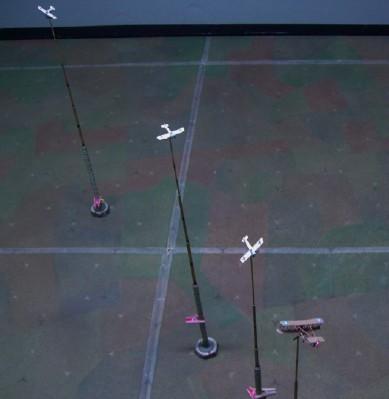
The Eindecker turned to find a place to land, and the British made good their escape across the lines as the other Germans managed only to see him off.
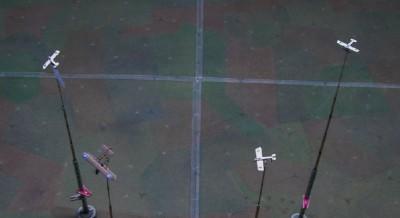
Both wounded ‘craft managed safe landings. I’ll admit that I didn’t hold much hope for history repeating itself, but aside from the survival of the British observer (Mitchell was killed in the encounter) things worked out pretty much as it did 100 years ago.
27/04/2016 at 16:27 #41314 Don GlewweParticipant
Don GlewweParticipantThe Fe2b gets another turn today, this time in its intended role as a fighter. George Maxwell of 25 Sq (w/ observer S.Sharpe) on line patrol takes exception to a German snooping over the trenches near Neuve Chapelle. The LVG* pilot saw the approaching Fee, turned East, throttled up, and dove for home. Maxwell did the same, and the chase was on.
This game came close to amounting to nothing, as their speeds were matched and the distance between them remained beyond gunnery range. As they went deeper and deeper into German territory and the LVG remained beyond harm, I decided to make the British roll greater than the number of miles behind the lines the pursuit carried them in order to continue. This is a picture that captures the excitement:

Four miles later they were still at it (and I was getting close to giving up on them since the crew of the Fee weren’t in the mood to do so themselves). A bit had changed in the situation, though: The ground got closer and the LVG had no choice but to level out. As the two slowed at differing rates (that’s AAR lingo for ‘dice’) the Fee inched closer to within long range. A clumsily botched ‘jink’ by the German pilot squandered more precious speed, and the British finally got to within effective range (having rolled a ‘6’ to stay with the fight).After suffering a few hits that did no significant damage, the LVG pilot chose to use his remaining speed/energy in an attempt to give his observer a good shot. It is easier to do that, however, when your gunner is in front of you instead of behind – Maxwell won the contest handily, which allowed Sharpe to put rounds into his target unmolested by return fire.
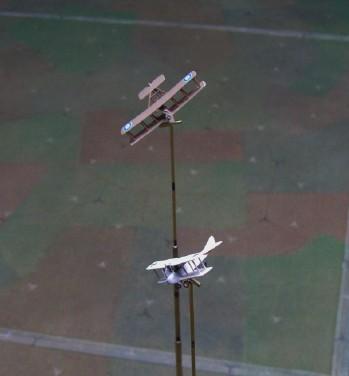
Taking what now amounted to a worrying number of hits, the German pilot noticed the lull in firing (Sharpe had run out of ammo) and broke away, hoping to nurse his battered machine to safety. Unlike the Nieuport, however, the Fee has two crew, and while Sharpe slapped on a new drum Maxwell maneuvered to remain tight on the tail of the fleeing German. The next shots into the LVG killed the observer and wounded the pilot. Sharpe reloaded again (and again…) until the LVG looked to be held together by little more than hope and prayer.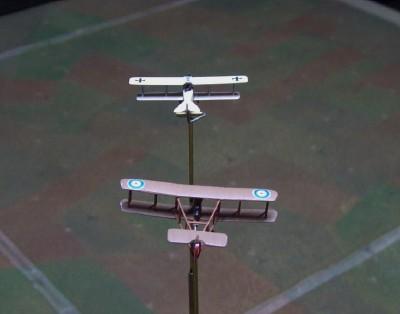
Maxwell finally tired of the sordid ordeal, realized they were low to the ground over five miles behind the lines, and turned for home. The forced landing of the LVG resulted in a crash.
As yesterday, it was interesting to find that the dice turned an “I doubt it will happen as it did” scenario into a fairly accurate reproduction: 100 years ago the official report credited Maxwell and Sharpe with a ‘forced to land’ victory over Herlies – which I found to be ~2 miles behind the lines.*proxy for the historical Aviatik that I still haven’t gotten around to building…sigh
 13/05/2016 at 21:41 #41967
13/05/2016 at 21:41 #41967 Don GlewweParticipant
Don GlewweParticipantAnother (too long) break from the dice.
Instead of choosing something from the ‘claims’ column, I decided to put a ‘What if?’ game on the table in honor of the first official combat patrol of the Escadrille Americaine (N124). Taking leave from history, the five-ship patrol (two new N16s and three N11s) headed north instead of east from their base at Luxeuil les Bains and ended up over the lines near St.Mihiel where the fledgling USAS would fight its first major battle in 28 months – close enough to Boelcke & Co. of KEK Sivry-sur-Meusse to risk an encounter. The setup was dictated by the dice (as cited previously: using Mike Clinton’s system from ‘Watch Your Six!’) and the spin goes like this…
Eager and inexperienced, one of the rookies (Chapman) saw something on the German side and went over to see what it was. It turned out to be a French Voisin just arriving over a town to snoop a bit. Chapman didn’t discover that, though, until he’d attracted the notice of a pair of Fokkers (vonAlthaus and vonHartmann) intent on disturbing the Voisin. The American also didn’t detect Boelcke who’d been following ever since Chapman had made the mistake of breaking off from his patrol.
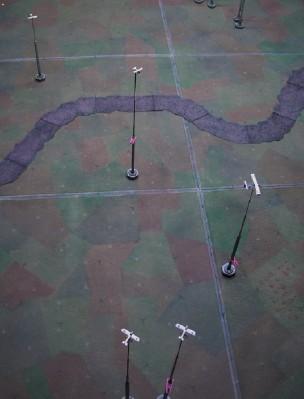
The patrol -led by Rockwell- had carried along on their side of the lines until Thaw (in one of the Nieuport 16s) noticed the missing member. He pulled up alongside Rockwell, wagged his wings, and pointed over his shoulder towards Chapman who was a little over two miles away.
(The stand of Boelcke’s machine is in the upper right of the photo.)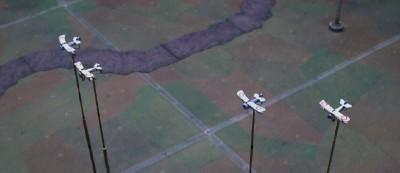
Facing only two opponents, Chapman felt no fear and turned to attack. The more experienced vonAlthaus easily countered, while vonHartmann held back for the moment. The Voisin -seeing it had its back covered- began its reconnaissance, spotting some infantry. Boelcke (in an E-IV model Fokker) had the devil’s own time trying to coax full power from his 160hp Oberursel, and failed to climb any nearer.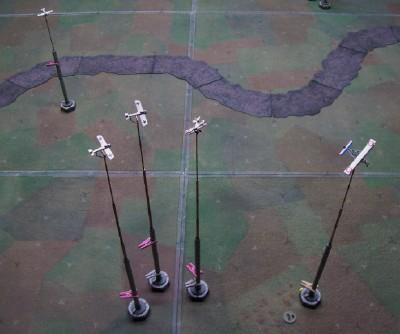
Meanwhile, the other Americans dithered about. Rockwell had turned in the direction Thaw had indicated, but couldn’t spot anything in the sky. Thaw tried to take the lead, but was having trouble getting the extra 30hp he carried in the N16 to show itself and so stayed in formation. Cpt.Thenault (the French Commander of the Escadrille) in the other N16 dutifully followed his leader -who seemed to be going in the right direction and so must have spotted the Germans, yes? The rookie McConnell (less than a month in a Nieuport) tagged along.This is how it looked from the French side of the lines as Boelcke finally got his engine running full tilt and was climbing well…it looked like the Germans would be able to dispatch the lone American and the snooping Frenchman before the cavalry (still a mile away) came over the hill.

The dice thought differently. VonHartmann thought to leave the wild gyrations of Chapman to vonAlthaus, and set his sights (and eyes) on doing something about the Voisin. Heading towards the Frenchman, however, brought vonHartmann directly in the path of vonAlthaus’ own gyrations, and instead of lining up his gun on the Voisin he found himself suffering a violent blow as the two Fokkers collided. His controls severely damaged, vonHartmann struggled to set up a coordinated glide to safety with all thoughts of combat banished.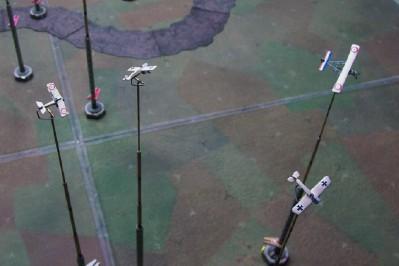
VonAlthaus -though not as damaged in the encounter- was in worse shape since his last-second effort to wrest his ‘craft away from the collision placed him on the verge of a stall and he found himself wallowing right in front of the gun of the pleasantly-surprised Chapman (“Gee, this dogfighting stuff is easy!”) who took full advantage of fate’s gift and rolled 4 hits on five dice.
No critical damage was done, but enough to convince the German that continuing the battle was not a good idea. Boelcke came to the same conclusion as his arrival on the scene coincided with that of the other Americans who -though half were still looking about wondering what was what- were near enough and had a 500 meter altitude advantage to make it folly for the German to stick around. A final picture of the scene as Boelcke turns and dives away…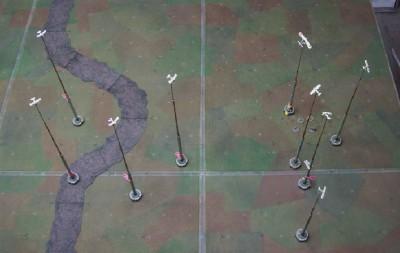
The Voisin had had excellent luck with the dice and succeeded in spotting more infantry, a column of lorries, and an artillery battery on the move – a good mission to go home with. What at the start looked to be a potential disaster for the Americans (given the setup) ended up being a decisive victory.14/05/2016 at 12:52 #41975 Don GlewweParticipant
Don GlewweParticipantFielding Americans for the first time raises the issue of what term to use for the sort of thing Chapman possessed/displayed. Although he came out okay, it could have easily gone the other way: He was rolling the maximum number of dice each round of combat and never exceeded his very low threshhold for failure – instead rolling a higher-than-average number of successes. anyway…
As mentioned upthread, I use ‘pluck’ for the British, ‘elan’ for the French, and ‘hallschmerzen’ for the Germans to describe over-eager bravery that may (or more likely may not) be backed up by the talent/resources to support it. ‘Guts’ has been suggested, but strikes me as too positive – I’m looking for something that matches the other terms inasmuch as they carry a good deal of negative baggage behind the pretty flag decal…any ideas?
14/05/2016 at 14:00 #41976 John D SaltParticipant
John D SaltParticipant“Mojo” is probably too recent for a WW1 game.
“Chutzpah” is probably not that applicable to goyim, and anyway should be reserved for the post-1948 extensions to the game system when you start doing Israeli pilots.
“Boldness”, “Audacity”, “Daring” or “Dash” are all about right, but not distinctively American.
If “guts” is not acceptable, other body parts associated with the quality in question are “spine”, “neck”, “bottom”, and “balls”. Spine is too complimentary; neck is too derogatory; bottom only makes sense in British English; and balls might be thought a trifle vulgar.
“Spunk” is probably the right kind of word, but liable to cause unwarranted childish amusement among British English speakers (which makes me recall that flight to the states when “Dancin’, Shaggin’ on the Boulevard” was a hit in the US, and playing on the in-flight movie screen — the flight attendants were bemused by the fact that the UK-born half of the passengers were turning puce in their attempts not to howl uncontrollably with laughter).
I would vote for “moxie”, which I think might be old enough for WW1, and sounds thoroughly American to me.
All the best,
John.
14/05/2016 at 21:29 #41981 Don GlewweParticipant
Don GlewweParticipantThanks, John, “moxie” sounds like a winner – especially since it is, at its root, a fizzy thing that’s supposed to be good for you…but probably isn’t!
14/05/2016 at 23:00 #41983 RogerBWParticipant
RogerBWParticipantUm. etymonline can’t find “moxie” meaning “courage” before 1930.
I don’t think “pluck” carries negative connotations in BrE – nobody gets blamed for being over-plucky. “Flair” might be better.
For the Americans, maybe “wahoo”?
-
AuthorPosts
- You must be logged in to reply to this topic.

